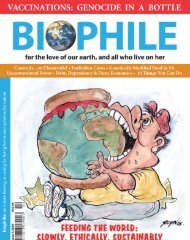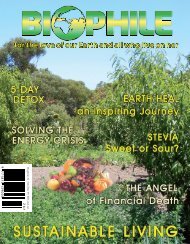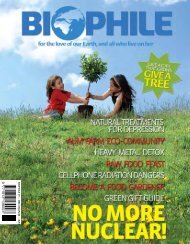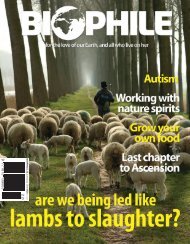BIOPHILE 16 â JUNE/JULY 2007 R25 - Biophile Magazine
BIOPHILE 16 â JUNE/JULY 2007 R25 - Biophile Magazine
BIOPHILE 16 â JUNE/JULY 2007 R25 - Biophile Magazine
- No tags were found...
Create successful ePaper yourself
Turn your PDF publications into a flip-book with our unique Google optimized e-Paper software.
BIOFILESFuelling extinction?Unsustainable biofuels threaten theenvironmentThere are many risks to biodiversityand the environment which resultfrom a growing biofuel market:The displacement of land-uses that areimportant to biodiversity. The mostimmediate risk is losing agricultural‘set-aside’ land. European farmers, forexample, are required to set aside someof their land and put it out of production.While not an environmentalmeasure, setaside has had huge benefitsto wildlife and has become a criticalpart of the European farmed landscape,acting as a refuge for farmland biodiversity.The harmful impact of energy cropmonocultures (concentrated growth ofa single crop over wide areas), excludingthe plants and animals which wouldotherwise contribute to the ecosystem,making fields ecological semi-deserts.Intensifying the production of energycrops, including new types like miscanthus(elephant grass), also increasesuse of fertilisers, energy and pesticides,which further damage the environmentand contribute to climate change.Biofuel growth can aggravate existingthreats to biodiversity.Losing natural habitats of globalimportance for wildlife and carbon storage,such as the Indonesian rainforestand the Brazilian Cerrado, through importingbiofuel feedstocks. Cultivatingvast plantations of palm oil, sugarcaneand soy may also cause soil erosion,harm water quality and bring socialproblems, such as displacing nativepeople and small farmers.• Many environmental organisationsbelieve the solution is to ensure thatonly the right kind of biofuels — thoseproduced sustainably which genuinelyoffer major greenhouse gas benefits— are used. A mandatory certificationsystem for biofuels must ensure minimumproduction standards are met andconfirm eligibility for public support.• Biofuels are only one of many technologieswhich reduce greenhouse gasemissions. Their role is restricted bylimited available land and competingland uses. Biofuel development musttherefore be part of a broader energypolicy focusing on energy saving andefficiency.• Biofuels are often termed ‘carbonneutral’ as they generally come fromorganic material that is then re-grown.In fact, production causes substantialGHG emissions, mainly from makingand using fertilisers and from fossilfuels used in processing. Using biofuelsmay even cause more emissionsthan conventional fuel. Savings can beincreased through good crop managementand minimising fossil fuel use inprocessing and fuel transport.• Biofuels are not an unlimited resource.We need land to grow biomassfor fuel, and our fuel demands are sovast that even small targets requiremajor land-use changes. This has amajor impact on bio-diversity and theenvironment.[Source: Birdlife International]As part of the Tierras Bajasproject, people have beenresettled from the Altiplanoto cultivate soybeans. Eachagricultural “pin wheel”pattern is centered on a smallcommunity. The communitiesare then spaced evenlyacross the landscape at 5-kmintervals. Roadways can be seenconnecting each town center.14<strong>Biophile</strong> Issue <strong>16</strong>
















